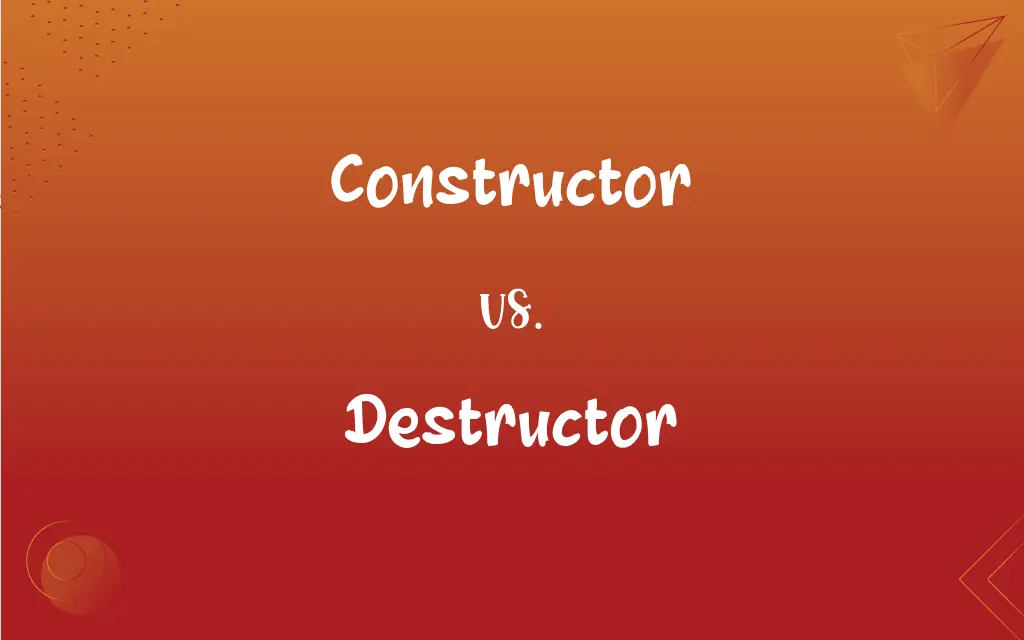Constructor vs. Destructor: What's the Difference?
Edited by Aimie Carlson || By Harlon Moss || Updated on October 20, 2023
Constructor initializes an object; destructor cleans up resources.

Key Differences
A constructor is a special method in an object-oriented programming language that is automatically called when an object of a class is created. A destructor, on the other hand, is called when the object goes out of scope or is explicitly destroyed.
The primary role of the constructor is to initialize the data members of the class and allocate memory if needed. The destructor, contrastingly, is responsible for deallocating the memory or cleaning up any resources that the object may have acquired during its lifetime.
Both constructor and destructor have unique characteristics. For instance, a class can have multiple constructors with different parameters, but it can only have one destructor. This single destructor ensures that resources are released appropriately.
The names of both constructor and destructor are defined by the programming language. In C++, the constructor has the same name as the class, while the destructor has the same name preceded by a tilde (~). Despite their differences, both constructor and destructor play pivotal roles in the lifecycle of an object.
Even though both are essential, their timings differ. The constructor is invoked at the beginning of an object’s lifecycle, ensuring it's ready for use. The destructor, in contrast, marks the end of the object’s life, making sure no lingering resources remain.
ADVERTISEMENT
Comparison Chart
Purpose
Initializes an object's state.
Cleans up resources and deallocates memory.
Number in a class
Can have multiple with different parameters.
Only one per class.
Naming in C++
Has the same name as the class.
Same name as the class but preceded by a tilde (~).
Invocation
Automatically called when an object is created.
Called when an object is destroyed or goes out of scope.
Resource management
Can allocate memory or resources.
Responsible for releasing memory or resources.
ADVERTISEMENT
Constructor and Destructor Definitions
Constructor
A method that initializes an object.
The constructor set the initial value of the variable.
Destructor
A special routine in OOP invoked upon object destruction.
As the program ended, the object's destructor was called.
Constructor
May be overloaded with different parameters.
The class had three constructors for varied data inputs.
Destructor
A method that cleans up an object's resources.
The destructor ensured there were no memory leaks.
Constructor
A special routine of a class in OOP.
We defined a custom constructor for user inputs.
Destructor
Helps in freeing the resources an object has consumed.
The file object's destructor closed the opened file.
Constructor
Establishes default properties of an object.
The rectangle's constructor sets its default dimensions.
Destructor
Marks the end of an object's lifecycle.
The vector's destructor released its dynamically allocated space.
Constructor
Initiates the instance variables of a class.
Without a proper constructor, the object might behave unpredictably.
Destructor
Opposite of a constructor in terms of functionality.
While the constructor set up the environment, the destructor dismantled it.
Constructor
To form by assembling or combining parts; build.
Destructor
An incinerator for refuse.
Destructor
An explosive, usually remote-controlled device for effecting a destruct.
FAQs
What is a constructor?
A method that initializes an object when it's created.
How does a destructor differ from a constructor?
A destructor cleans up resources when an object is destroyed, while a constructor initializes an object.
How many destructors can a class have?
Only one.
Can constructors and destructors have return types?
No, they don't have return types.
Is it mandatory to define a constructor or destructor for a class?
No, if not defined, the compiler provides default ones.
Do all OOP languages support destructors?
Not all. Some languages rely on garbage collectors, reducing the need for explicit destructors.
Do constructors and destructors perform the same tasks?
No, constructors initialize, while destructors clean up.
How are constructors and destructors named in C++?
Constructors have the same name as the class; destructors have the class name but preceded by a tilde (~).
How do destructors aid in resource management?
They ensure that resources like memory, file handles, and network connections are released.
Can a class have multiple constructors?
Yes, constructors can be overloaded with different parameters.
When is a constructor called?
When an object of the class is instantiated.
How do constructors and destructors work in inheritance?
Constructors are called top-down (base to derived), while destructors are called bottom-up (derived to base).
Can we explicitly call constructors or destructors?
Constructors can be explicitly called, but it's not recommended. Destructors can be invoked using delete (in languages like C++), but not directly.
What's the significance of parameterized constructors?
They allow objects to be initialized with specific values.
Can a destructor allocate resources?
Though technically possible, it's against its typical purpose.
Why are destructors important?
They ensure resources like memory are properly released, preventing memory leaks.
Why might a constructor fail?
Reasons include insufficient memory or invalid initial values.
What happens if an exception is thrown in a constructor or destructor?
If thrown in a constructor, the object creation fails. In a destructor, it might lead to a program termination or undefined behavior.
What is the lifecycle of an object concerning constructors and destructors?
The constructor is called at the start, initializing the object, and the destructor at the end, cleaning up resources.
When is a destructor invoked?
When an object is destroyed or goes out of scope.
About Author
Written by
Harlon MossHarlon is a seasoned quality moderator and accomplished content writer for Difference Wiki. An alumnus of the prestigious University of California, he earned his degree in Computer Science. Leveraging his academic background, Harlon brings a meticulous and informed perspective to his work, ensuring content accuracy and excellence.
Edited by
Aimie CarlsonAimie Carlson, holding a master's degree in English literature, is a fervent English language enthusiast. She lends her writing talents to Difference Wiki, a prominent website that specializes in comparisons, offering readers insightful analyses that both captivate and inform.































































